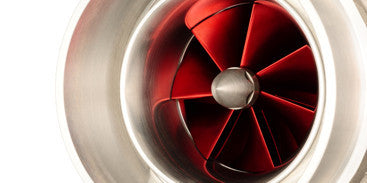EA825 Installation Instructions - C8
Step 1 - Disconnect both 12V and 48V Systems
Important !!! Both High and Low Voltage systems must be de-energized as per manufacturer's instructions.
A good overview of this procedure is provided in the YT video below:
Step 2 - Unit Mounting
PM5 is not sealed so it must be installed inside the vehicle where it will not be exposed to dirt and moisture. Typical mounting location is in the trunk - most often in one of the two locations shown in the spare tire area.

In order to route the PM5 wires, rear seats will need to be removed as well as the rear panel sill plate.

General Pump and Power Wiring should be routed from the PM5 mounting location as follows:

Step 3 - 12V Power Connections
PM5 requires two fused 10AWG (5.0mm^2) wire connections. The two fuseholders are provided with pre-crimped M5 ring terminals. These ring terminals will attach to the positive distribution block using the mounting screw for the thin blue wire shown below.
Start by removing the mounting screw using a Torx T25 screwdriver bit.

Install one of the provided PM5 fuseholders as shown. Make sure the yellow ring terminal's flat side is facing down (and the crimped wire is facing up) - as shown.

Next, install the OEM ring terminal with the thin blue wire and then install the second PM5 fuse holder ring terminal on top of it. In other words, the OEM blue wire ring terminal should be "sandwiched" between the two yellow PM5 ring terminals. Ensure the 3 ring terminals are stacked and rotated as shown in the photo below so that all 3 of them sit flat when the black screw is reinstalled, fastened and torqued down to 3.5Nm.

Route the two PM5 ring terminals as shown so they fit inside the plastic cover once it's closed.

Plug the 4-wire PM5 Battery Power Harness into the PM5 and cleanly route the 2 positive Red 10AWG (5.0mm^2) wires under the carpet and into the battery compartment where the the two PM5 fuse holders are now located. Cut off the excess wire so there is some service length and strip the ends. Using the provided yellow sealed splices and a crimper, connect each wire to one of the fuse holders. Repeat for the other wire. Gently pull on the splices to make sure the wires are properly crimped. Using a heat gun, shrink the splices.
Step 4 - Ground Connections
Cleanly route the 2 negative Black 10AWG (5.0mm^2) wires under the carpet and into the battery compartment. These will connect to the grounding stud location just left of the battery shown here:

Cut off the excess wire so there is some service length and strip the ends. Using the provided yellow M6 ring terminals and a crimper, crimp the ring terminals onto each wire. Gently tug on each ring terminal to ensure the wires were properly crimped. Remove the M6 nut from the OEM grounding stud and add the two PM5 ring terminals. Making sure all ring terminals are rotated so they are sitting flat. Reinstall the nut and torque it down to 20Nm.
Important !!! - Two different Pump/ECU wiring adapters were provided:
Length of 3 thick Red/White/Green wires needs to be kept as short as possible,
Length of the 2 thinner Blue/Black wires is not critical.
OEM Fuel Pump Control Module (J538) is located under the car just in front of the passenger-side rear wheel.

The OEM J538 module will need to be removed and replaced by Torqbyte Plug-n-Play wire adapter as shown.

Step 5 - Pump/ECU Wire Routing
Route the 3 thicker 10AWG (5mm^2) wires (Green/Red/White) from the PM5, under the rear seats and install under the metal sealing flange cover.

It may be necessary to make a 2 small cuts in the sealing flange cover so the sheet metal can be bent upwards allowing more room for the additional wires to pass through.

With this option the provided PnP 4-Way connector plugs directly into the tophat. The OEM connector previously at this location needs to be left disconnected. However, it should be protected and secured so it does not get damaged by dirt and moisture.

The 2 thinner wires may also be routed under the sealing flange cover as described above and then routed over the fuel tank towards the OEM J538 mounting location.
Alternately, the following sealing grommet in the trunk may be used for the thin wires. It is located on the passenger-side of the spare tire area.

It has some spare wire cavities as can be seen from the underside of car.

Important !!! Wires on the underside of the car must be routed away from the exhaust and secured to non-moving features using zip ties.
Step 6 - Optional CANBus Connection
PM5 can monitor the Hybrid CANBus traffic to extract RPM and Throttle Position readings which can be used to control the pump booster voltage (default PM5 configuration uses a fixed booster voltage of 22Vdc).
CANBus electrical connection is made by installing the provided "CANBus tee" inserted between the 12V/48V Converter and its OEM wiring.

Simply unplug the factory 10-Way connector from the 12V/48V Voltage Converter, plug one end of the provided 10-Way adapter into the Voltage Converter and plug the factory connector into the other end of the provided adapter. Route the 2 twisted wires from the 3D printed junction block under the carpet all the way from the battery compartment to the PM5.
Note: The 3D printed junction block on the Torqbyte CANBus adapter has a spare "port" that can be conveniently used for other equipment that may require a CANBus connection (e.g. Active Suspension Control or Upgraded Exhaust).
Step 7 - Install PM5 Fuses and Re-Energize the SCR System
Install the supplied green 40A fuses into the two fuse holders from Step 3 and re-assemble everything in the battery compartment.
Re-energize the Starting-Charging system as shown in the YouTube video in Step 1.


